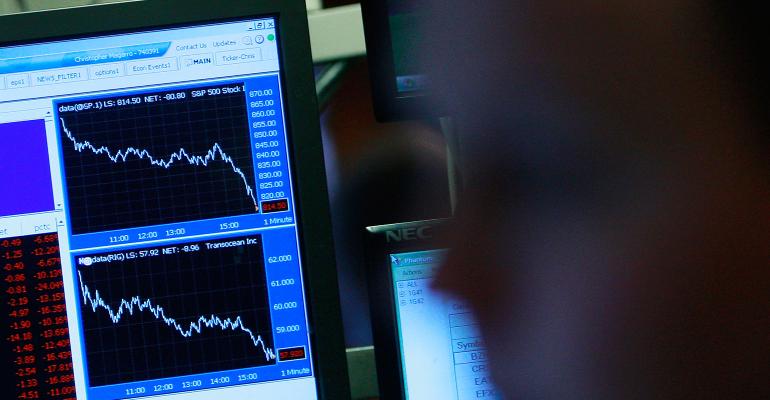(Bloomberg) -- Recession. Just the mention of it sends shivers down the spine of even the most stalwart on Wall Street. But not among sellers of exchange-traded funds.
A growing number of asset managers see a prolonged downturn spurring the next big cash injection for the $4.5 trillion U.S. industry which, after years of meteoric growth, is showing signs of slowing down. While assets rose 32% in 2019, fund debuts shrank to the lowest in five years and liquidations jumped.
Naysayers have been forecasting a recession for years as the U.S. extends its longest period of continuous growth in more than a century. But as companies try to cycle-proof their businesses, there’s a growing roster of ETF providers who think a significant correction could scare billions of dollars out of mutual funds -- and see them reinvested in ETFs.
“We know the market’s going to trend down at some point and it could be the next wave -- it could catalyze the next wave -- of ETF adoption,” Rich Powers, Vanguard Group’s head of ETF product management, said at a conference in December. There’s precedent, he said, arguing that the global financial crisis was “one of the great catalysts for the adoption and acceleration of ETFs.”
Certainly, money managers like Vanguard and BlackRock Inc. have done very well since the crash as investors increasingly adopt passive products, but the connection between the two is a little counterintuitive. If negative growth curtails the stock market’s bull run, you can bet ETFs will slide as investors head to the exits. But the argument goes that this short-term pain could ultimately translate to long-term gain for money managers.
That’s because a downturn could also prompt redemptions from mutual funds -- ETFs’ main rival for assets -- and this money could flow back into the market via cheaper ETFs. Active managers, who pick and choose investments, will come under heightened pressure to beat their benchmarks during times of stress and any underperformance may augment the appeal of indexed products.
“The spikes in growth are always when assets move from the incumbency, from where they’re stuck to the new places,” said Michael Venuto, co-founder and chief investment officer of Toroso Investments. “A lot of the ETF growth is new assets coming in; what we’re talking about is the $14 trillion that’s over there in mutual funds and unsticking it.”
History shows that market pullbacks have been beneficial for ETF flows, according to a study in 2018 by Toroso.
For example, many investors in actively-managed strategies flocked to low-cost passive funds following the collapse of Lehman Brothers in September 2008, despite the stock market taking another six months to bottom out. Stock ETFs saw inflows of nearly $64 billion in the three months that followed the bank’s fall, data compiled by Bloomberg show. After 12 months, inflows totaled more than $66 billion.
By contrast, equity mutual funds saw outflows of $109 billion in the quarter after Lehman failed, according to the Investment Company Institute. Investors added just $15 billion back to these funds over the subsequent nine months, leaving flows in 2009 far below the $73 billion that was contributed in 2007, the data show.
Some of the shift comes down to cost. Investors in active funds pay about 4.5 times more than those in passive products, the widest disparity since 2000, according to a 2018 Morningstar Inc. study. The cheapest ETF costs as little as 20 cents for every $1,000 invested, a major draw for anyone disillusioned with stock-picking, data compiled by Bloomberg show.
Tax is also a factor, with investors disincentivized from selling their mutual funds in good times for fear of incurring capital gains. But a downswing could reduce those gains and create a strong motive to bail. Investors could then choose to buy a low-cost ETF over a higher-cost, underperforming mutual fund when the market recovers.
Whatever the reasoning, ETFs have become more versatile compared with other fund formats and are easier to trade, said Ben Johnson, an analyst at Morningstar. “Thus, investors of all stripes with different needs, views, and time horizons have and will continue to gravitate toward the format.”
--With assistance from Lu Wang and Tom Lagerman.
To contact the reporter on this story:
Vildana Hajric in New York at [email protected]
To contact the editors responsible for this story:
Jeremy Herron at [email protected]
Rachel Evans, Randall Jensen





